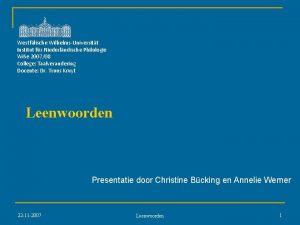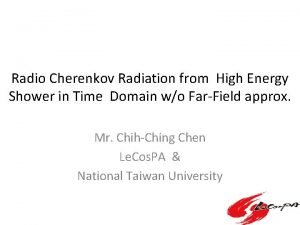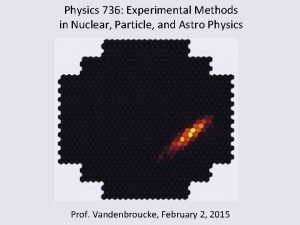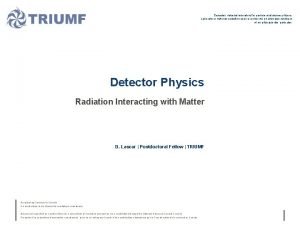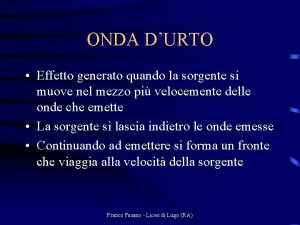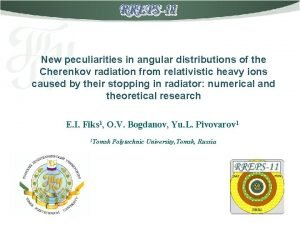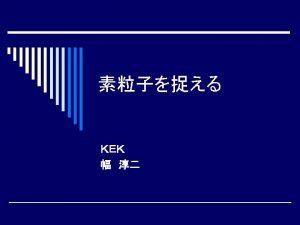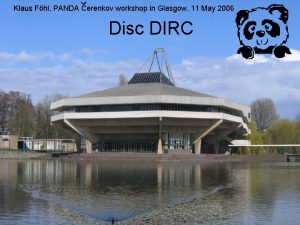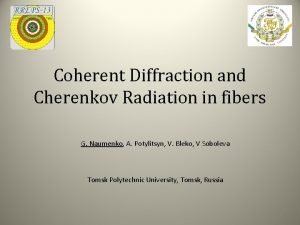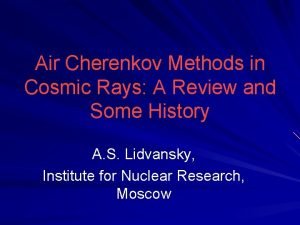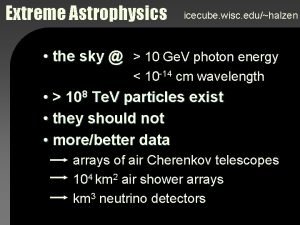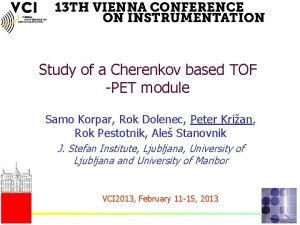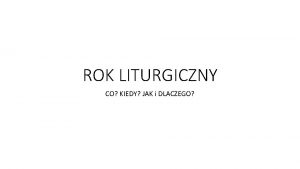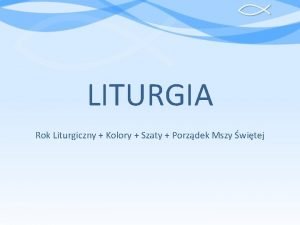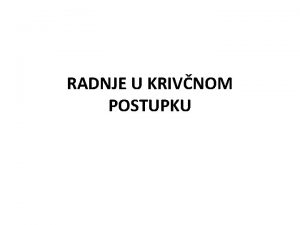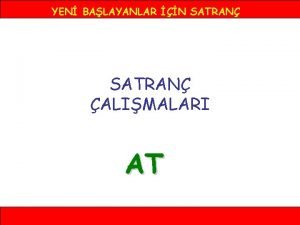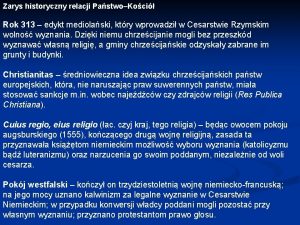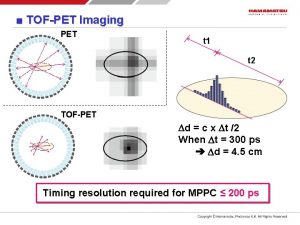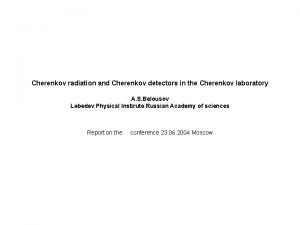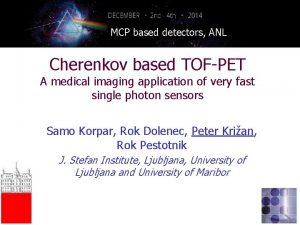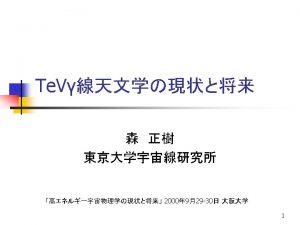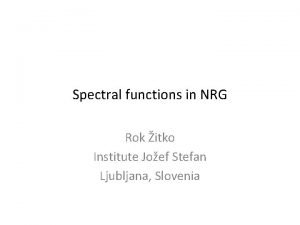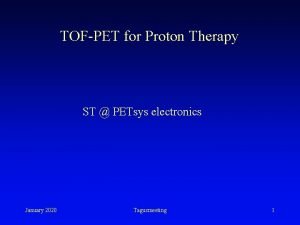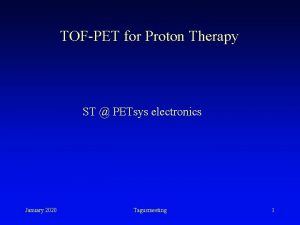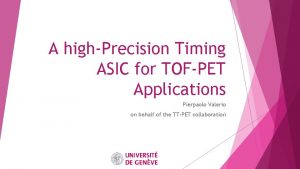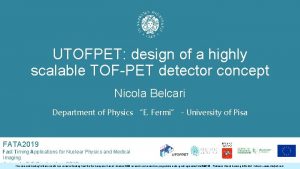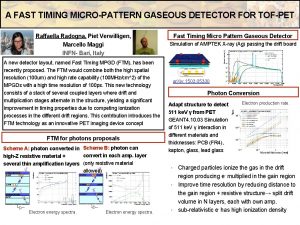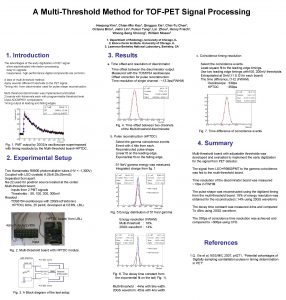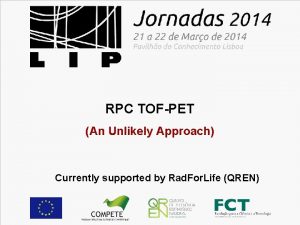Using Cherenkov light in TOFPET Rok Pestotnik Joef
























- Slides: 24

Using Cherenkov light in TOF-PET Rok Pestotnik Jožef Stefan Institute On behalf of the Ljubljana group: Peter Križan, Samo Korpar, Rok Dolenec, Dania Consuegra, Gašper Razdevšek, Rok Pestotnik FATA 2019 Rok Pestotnik, Ljubljana 1

Contents Cherenkov radiation in particle physics Detection of annihilation gammas in a Cherenkov radiator Cherenkov based TOF-PET Sensors: MCP-PMT, Si. PM Cherenkov based PET scanner Conclusions and summary FATA 2019 Rok Pestotnik, Ljubljana 2

Particle ID in particle physics: use of Cherenkov radiation A charged track with velocity v=bc exceeding the speed of light c/n in a medium with refractive index n emits polarized light at a characteristic (Cherenkov) angle, cosq = c/nv = 1/bn Cherenkov photons detected on a plane ring (Ring Imaging Cherenkov counter, RICH) ring radius Cherenkov angle velocity (c/n) t vt Excellent identification method ARICH prototype for Belle II Very low light level = few detected photons Needs a fine granularity sensor for single photons with low noise FATA 2019 Rok Pestotnik, Ljubljana 3

Medical Imaging with PET Positron emission tomography: Functional imaging with biomarkers containing a beta+ emitter Fluorodeoxyglucose (FDG) is the most commonly used marker indicates the uptake of glucose – body line of response (LOR) FATA 2019 detector ring Rok Pestotnik, Ljubljana 4

TOF-PET To improve the contrast of images, Time-of-Flight difference of annihilation gammas is used Localization of source position along the line of response: t ~ 66 ps → x = c 0 t/2 ~ 1 cm TOF t = coincidence resolving time, CRT non TOF PET systems based on Si. PM readout are reaching CRT of ~200 ps, and only with small crystals ~3 x 3 x 3 mm 3 CRT<100 ps FATA 2019 Rok Pestotnik, Ljubljana 5

Gamma detectors for PET Scintillating crystal: converts gamma energy into optical photons Time resolution in TOF PET limited by photodetector response scintillation light emission (rise and decay time constants) optical photon travel time spread in the crystal readout electronics Photodetector converts optical photons into electrical pulses BGO LSO La. Br 3(Ce) Density (g/cm 3) 7. 1 7. 4 5. 1 μ 511 ke. V (cm-1) 0. 96 0. 87 0. 43 Photofraction for 511 ke. V (*) 0. 41 0. 32 Decay time (ns) 300 40 17 3, 000 15, 000 30, 000 Light yield (/511 ke. V) (*) [XCOM: Photon Cross Sections Database] Limitation due to scintillator can be avoided by using prompt Cherenkov light instead FATA 2019 Rok Pestotnik, Ljubljana 6

Annihilation gamma detection with Cherenkov light Fast photon detectors – MCP-PMT and Si. PM – have excellent timing resolution Cherenkov light is promptly produced by a charge particle traveling through the medium with velocity higher than the speed of light c 0/n. Photoelectron emits Cherenkov light in ~1 ps. Disadvantage : small number of Cherenkov photons produced per interaction N ΔE ≈ 2 cm sine. V ϑ 370 l C ≈ electron 511 ke. V Cherenkov ph. 370× 0. 01× 2× 0. 75 ≈ 8 → detection at a single photon level! FATA 2019 Rok Pestotnik, Ljubljana 7

Cherenkov radiator Pb. F 2 An excellent candidate Cherenkov radiator for detection of annihilation gammas: • high gamma stopping power • high fraction of gamma interactions via photoeffect → electrons with maximal kinetic energy → more Cherenkov photons • high transmission for visible and near UV Cherenkov photons Pb. F 2 n (g/cm 3) 7. 77 1. 82 e- Cherenkov threshold (ke. V) 101 Cutoff wavelength (nm) 250 Attenuation length (cm) 0. 91 Photofraction 46% LYSO 7. 4 1. 14 32% La. Br 3 5. 1 2. 23 15% FATA 2019 Rok Pestotnik, Ljubljana 8

Intrinsic suppression of scattered events PET with scintillators: large number of scintillation photons → gamma energy only photo-peak accepted → rejection of scattered events Cherenkov PET: only a few Cherenkov photons detected → no energy information efficiency drops with gamma energy→ intrinsic suppression FATA 2019 Rok Pestotnik, Ljubljana 9

Excellent TOF PET timing with MCP PMTs Pioneering experiment, two detectors in a back-to-back configuration: q Cherenkov radiators: 25 x(5, 15) mm 3 Pb. F 2 q MCP-PMT photodetectors: • single photon timing ~ 50 ps FWHM • active surface 22. 5 x 22. 5 mm 2 electron 511 ke. V Cherenkov ph. black painted, Teflon wraped, bare Timing resolution (black painted): ~ 70 ps FWHM, 5 mm crystal ● ~100 ps FWHM 15 mm crystal Efficiency (Teflon wrapped): ● ~ 6%, single side (typically ~ 30% for LSO) ● NIM A 654(2011)532 FATA 2019 Rok Pestotnik, Ljubljana 10

Reconstruction - experiment Two 22 Na point sources at +10 mm and -10 mm 4 x 4 segmented, black painted Pb. F 2 radiators (non-TOF) FBP TOF w. FBP MLP Filtered MLP A simple, very fast Most-likely-point (MLP) method (~histograming of points) already gives a reasonable image NIM A 732 (2013) 595 Ljubljana FATA 2019 Rok Pestotnik, 11

Cherenkov based PET scanner? Pb. F 2 not a scintillator considerably cheaper! Smaller attenuation length than LYSO smaller parallax error Cheaper normal scanner or Total/half body device Extending axial FOV 20 cm 200 cm: estimated 6 -fold increase in SNR • Better image quality • OR Shorter scanning time • OR Less injected activity: 8 m. Sv 0. 2 m. Sv Is such a PET scanner feasible? Can Si. PMs be used for light detection? Pro: high PDE, low cost, insensitivity to B field (PET/MR) But: limited timing (200 ps FWHM SPTR), high dark count rates (~100 k. Hz/mm 2) FATA 2019 Rok Pestotnik, Ljubljana 12

Cherenkov based scanner – image quality simulation Evaluate performance of Cherenkov PET method GATE simulations geometry of whole-body TOF-PET scanner (Siemens Biograph TP) CASTo. R reconstruction (iterative, TOF) including un-suppressed scattering image quality metric: percent contrast (Qc) traditional LSO scintillator QC, 10=63 QC, 22=73 FATA 2019 200 ps TOF LSO Y AR N I IM EL R P Pb. F 2 Cherenkov scanner QC, 10=66 QC, 22=81 100 ps photodetector TTS Pb. F 2 Y AR N I IM EL R P Rok Pestotnik, Ljubljana 13

Cherenkov based PET scanner - MC study Comparison of LSO and Pb. F 2 standard axial length scanners: NEC rate, noise-equivalent count rates, corrected for random and scatter coincidences S. Stute et al. , preliminary Gamma detector block: • a Pb. F 2 crystal and • a Si. PM as light sensor single gamma detector simulated in GEANT 4, then transferred to GATE Pb. F 2 TOF 100 ps NEC rates vs. activity, following the Conti formula (with-TOF) Pb. F 2 TOF 200 ps LSO TOF 527 ps Results: • 20% improved spatial resolution, as is now achieved using one-to-one coupling. • Sensitivity will be about one half, but noise equivalent count rate can be expected to be as good as or better than the standard PET scanner, if TOF resolution is 200 ps or better. FATA 2019 Rok Pestotnik, Ljubljana 14

Si. PMs as light sensors for the detection of few Cherenkov photons – experiment Coincidence time resolution Single side efficiency Teflon wrapped black paint light tight, temperature controlled freezer box best efficiency: ~30% with Sens. L Si. PM and Teflon wrapped crystals ● T = -25 o. C ● 22 Na crystals Si. PMs best timing: ~300 ps with Advan. Si. D ● T = -25 o. C ● (note: 5 x 5 mm 2 crystal on 3 x 3 mm 2 Si. PM!) FATA 2019 S. Rok. Korpar, IEEE/NSS Pestotnik, Ljubljana 2015 15

The first pair of PET 4 x 4 modules Pb. F 2+Si. PMs in test The module: • a 4× 4 array of 3× 3× 15 mm 3 Pb. F 2 crystals coupled to • a 4 x 4 array of Hamamatsu S 13361 -3075 Si. PM photosensors. Two modules and a rotating source to form a virtual PET ring with R=51 mm FATA 2019 Rok Pestotnik, Ljubljana 16

4 x 4 PET module - Experimental results EASIROC readout Results: 35% average efficiency (single side) point source reconstruction (2 modules) CASTo. R image reconstruction (no TOF) Single side detection efficiency FATA 2019 Source @ 0 mm Source @ -5 mm Rok Pestotnik, Ljubljana 17

Si. PMs as sensors for Cherenkov PET - summary Summary of studies with 15 mm crystals and Si. PMs as sensors • Efficiency: as high as 35% (for a teflon wrapped Pb. F 2 crystal) • TOF resolution: 300 ps FWHM (for a black painted crystal) limited by Si. PM response Combine the best of the two options? 15 mm 3 x 5 mm 511 ke. V electron FATA 2019 photodetector Cherenkov ph. Rok Pestotnik, Ljubljana 18

Limitations of fast timing d = 15 mm, n = 1. 8: Cherenkov photon photodetector 511 ke. V gamma photodetector Cherenkov photons are produced promptly, but still need time to reach the photodetector. Gamma rays travel faster than Cherenkov light! Radiator dimensions, refractive index → intrinsic travel time spread due to different gamma interaction depths. t = d∙n/c 0 = 90 ps t = d/c 0 = 50 ps → ∆t = 40 ps d = 15 mm, n = 1. 8: Cherenkov photon t = 0 ps photodetector 511 ke. V gamma photodetector For a 15 mm crystal the resulting FWHM contribution is ~90 -50=40 ps It gets even worse if the sensor is on the upstream side of the crystal Cherenkov photon t = d/c 0 + d∙n/c 0 = (50+90) ps → ∆t = 140 ps For a 15 mm long crystal the resulting FWHM contribution is ~140 ps FATA 2019 Rok Pestotnik, Ljubljana 19

Limitations of any very fast photon timing 2 Gamma rays travel faster than light! Radiator dimensions, refractive index → intrinsic travel time spread due to different gamma interaction depths 40 ps FWHM contribution in a 15 mm long crystal if sensor downstream This limitation is common to all very fast light emission mechanisms. FATA 2019 photodetector 511 ke. V gamma photodetector Can in principle be mitigated by – a multi layer configuration with shorter crystals, or by – measuring the depth of interaction (DOI) Rok Pestotnik, Ljubljana 20

Simulations - Multi-layer detector 3 layers of (5 * 5) mm 3 Pb. F 2 + (5 * 5) mm 2 Si. PM Photodetector time spread (TTS) = 0 ps → 22 ps FWHM TOF resolution Photodetector time spread (TTS) = 100 ps → 143 ps FWHM TOF resolution Arranged in a whole-body PET scanner with 20 cm axial coverage Contrast-to-noise (CNR) for phantom hot spheres (uptake TTS ratio = 3): = 0 ps TTS = 100 ps P FATA 2019 L E R I M I N Y R A P L E R I M I N Y R A diffuse = white reflector black = black paint ML = multi-layer Rok Pestotnik, Ljubljana 21

DOI in Cherenkov based g detectors By measuring DOI we would • Improve the timing • Further mitigate the paralax error A very interesting novel concept: Ca. LIPSO (D. Yvon et al. , CEA Saclay) Use a heavy high Z liquid, Tri. Methyl Bismuth (TMBi), for gamma conversion and dual mode detection • Cherenkov light for timing Pixellized charge collection (energy and 2 D postion) • Ionisation for energy measurement and 3 D gamma interaction point determination (2 D pixels for charge D. Yvon et al. , IEEE TNS, 61 (2014) 60. collection and drift time) Nice example of technology transfer from HEP medical imaging FATA 2019 Rok Pestotnik, Ljubljana 22

More ideas: Cherenkov++ … 2 /6 sided readout S. Ziegler et al. , Cherencube Combine Cherenkov photons (time) and scintillator photons (efficiency): pioneered by P. Lecoq et al. , S. Brunner et al. S. Brunner: revival of BGO scintillator? (good TOF with Cherenkov, low price, high density and photo-fraction but still worse than Pb. F 2) Harry van der Graaf: Tipsy as photodetector More ideas around with multiple layer devices etc - stay tuned for more! FATA 2019 Rok Pestotnik, Ljubljana 23

Summary Cherenkov radiation based annihilation gamma detectors offer a promising method for a very fast detection They can be used to build potentially cheaper devices or total body scanners. Total body scanner - another benefit: Pb. F 2 has a shorter attenuation length shorter crystals smaller parallax error. Si. PMs have been proven to work as sensors for Cherenkov light from annihilation gamma absorption. The single side efficiency is comparable to LSO scintillator based detectors. First tests of 4 x 4 modules with Pb. F 2 crystals and Si. PMs as light sensors, efficiency measurement and source reconstruction were made Improvements in Si. PM timing would further boost this detection method. More ideas around - stay tuned! FATA 2019 Rok Pestotnik, Ljubljana 24
 Soorten leenwoorden
Soorten leenwoorden Cherenkov light
Cherenkov light Cherenkov light
Cherenkov light Light light light chapter 23
Light light light chapter 23 Light light light chapter 22
Light light light chapter 22 Chapter 22
Chapter 22 Cherenkov radiation formula
Cherenkov radiation formula 736
736 Cherenkov radiation
Cherenkov radiation Effetto cherenkov
Effetto cherenkov Cherenkov radiation formula
Cherenkov radiation formula Cherenkov radiation
Cherenkov radiation Cherenkov
Cherenkov Cherenkov radiation
Cherenkov radiation Cherenkov spectrum
Cherenkov spectrum Cherenkov
Cherenkov Cherenkov radiation
Cherenkov radiation Cherenkov
Cherenkov Rok liturgiczny kolory
Rok liturgiczny kolory Lawetarz
Lawetarz Procesne radnje
Procesne radnje Dell rok license
Dell rok license Satrançta at piyonun üstünden atlar mı
Satrançta at piyonun üstünden atlar mı Kwaliteitsdecreet onderwijs
Kwaliteitsdecreet onderwijs Rok 313
Rok 313
